ZHCSD45 December 2014 OPA2277-EP
PRODUCTION DATA.
7 Specifications
7.1 Absolute Maximum Ratings(1)
over operating free-air temperature (unless otherwise noted)| MIN | MAX | UNIT | |||
|---|---|---|---|---|---|
| Supply voltage | 36 | V | |||
| Input voltage | (V–) – 0.7 | (V+) + 0.7 | V | ||
| Output short-circuit (to ground)(2) | Continuous | ||||
| Operating temperature | –55 | 125 | °C | ||
| Junction temperature | 150 | °C | |||
| Lead temperature (soldering, 10 s) | 300 | °C | |||
| Tstg | Storage temperature range | –55 | 125 | °C | |
(1) Stresses beyond those listed under absolute maximum ratings may cause permanent damage to the device. These are stress ratings only, and functional operation of the device at these or any other conditions beyond those indicated under recommended operating conditions is not implied. Exposure to absolute-maximum-rated conditions for extended periods may affect device reliability.
(2) One channel per package.
7.2 ESD Ratings
| VALUE | UNIT | |||
|---|---|---|---|---|
| V(ESD) | Electrostatic discharge | Human body model (HBM), per ANSI/ESDA/JEDEC JS-001, all pins(1) | ±2000 | V |
| Machine model (MM) | ±100 | |||
(1) JEDEC document JEP155 states that 500-V HBM allows safe manufacturing with a standard ESD control process.
7.3 Recommended Operating Conditions
over operating free-air temperature range (unless otherwise noted)| MIN | NOM | MAX | UNIT | |||
|---|---|---|---|---|---|---|
| VS | Specified voltage range | ±5 | ±15 | V | ||
| Operating voltage range | ±2 | ±18 | V | |||
| TJ | Operating junction temperature | –55 | 125 | °C | ||
7.4 Thermal Information
| THERMAL METRIC(1) | OPA2277 | UNIT | |
|---|---|---|---|
| D | |||
| 8 PINS | |||
| RθJA | Junction-to-ambient thermal resistance | 91.9 | °C/W |
| RθJC(top) | Junction-to-case (top) thermal resistance | 39.9 | |
| RθJB | Junction-to-board thermal resistance | 40.6 | |
| ψJT | Junction-to-top characterization parameter | 3.9 | |
| ψJB | Junction-to-board characterization parameter | 39.6 | |
| RθJC(bot) | Junction-to-case (bottom) thermal resistance | N/A | |
(1) For more information about traditional and new thermal metrics, see the IC Package Thermal Metrics application report, SPRA953.
Electrical Characteristics
At TA = 25°C, VS = ±5 V to ±15 V, RL = 2 kΩ (unless otherwise noted).| PARAMETER | TEST CONDITIONS | MIN | TYP | MAX | UNIT | ||||
|---|---|---|---|---|---|---|---|---|---|
| OFFSET VOLTAGE | |||||||||
| VOS | Input offset voltage | ±20 | ±65 | µV | |||||
| vs temperature, TJ = –55°C to 125°C | ±150 | µV | |||||||
| vs temperature (dVOS/dT), TJ = –55°C to 125°C | ±0.15 | µV/°C | |||||||
| vs power supply (PSRR) | VS = ±2 V to ±18 V | ±0.3 | ±1 | µV/V | |||||
| TJ = –55°C to 125°C | VS = ±2 V to ±18 V | ±1 | |||||||
| vs time | 0.2 | µV/mo | |||||||
| Channel separation (dual) | dc | 0.1 | µV/V | ||||||
| INPUT BIAS CURRENT | |||||||||
| IB | Input bias current | ±0.5 | ±2.8 | nA | |||||
| TJ = –55°C to 125°C | ±7 | ||||||||
| IOS | Input offset current | ±0.5 | ±2.8 | nA | |||||
| TJ = –55°C to 125°C | ±7 | ||||||||
| NOISE | |||||||||
| Input voltage noise, ƒ = 0.1 to 10 Hz | 0.22 | µVpp | |||||||
| 0.035 | µVrms | ||||||||
| en | Input voltage noise density | ƒ = 10 Hz | 12 | nV/√Hz | |||||
| ƒ = 100 Hz | 8 | ||||||||
| ƒ = 1 Hz | 8 | ||||||||
| ƒ = 10 Hz | 8 | ||||||||
| in | Current noise density | ƒ = 1 kHz | 0.2 | pA/√Hz | |||||
| INPUT VOLTAGE RANGE | |||||||||
| VCM | Common-mode voltage range | (V–) + 2 | (V+) – 2 | V | |||||
| CMRR | Common-mode rejection TJ = –55°C to 125°C |
VCM = (V–) + 2 V to (V+) – 2 V | 115 | 140 | dB | ||||
| VCM = (V–) + 2 V to (V+) – 2 V | 115 | dB | |||||||
| INPUT IMPEDANCE | |||||||||
| Differential | 100 || 3 | MΩ || pF | |||||||
| Common-mode | VCM = (V–) + 2 V to (V+) – 2 V | 250 || 3 | GΩ || pF | ||||||
| OPEN-LOOP GAIN | |||||||||
| AOL | Open-loop voltage gain TJ = –55°C to 125°C |
VO = (V–) + 0.5 V to (V+) – 1.2 V, RL = 10 kΩ |
140 | dB | |||||
| VO = (V–) + 1.5 V to (V+) – 1.5 V, RL = 2 kΩ |
126 | 134 | |||||||
| VO = (V–) + 1.5 V to (V+) – 1.5 V, RL = 2 Ω |
126 | ||||||||
| FREQUENCY RESPONSE | |||||||||
| GBW | Gain bandwidth product | 1 | MHz | ||||||
| SR | Slew rate | 0.8 | V/µs | ||||||
| Settling time | 0.1% | VS = ±15 V, G = 1, 10-V step | 14 | µs | |||||
| 0.01% | VS = ±15 V, G = 1, 10-V step | 16 | µs | ||||||
| Overload recovery time | VIN x G = VS | 3 | µs | ||||||
| Total harmonic distortion + noise (THD + N) |
ƒ = 1 kHz, G = 1, VO = 3.5 Vrms | 0.002% | |||||||
| OUTPUT | |||||||||
| VO | Voltage output | RL = 10 kΩ | (V–) + 0.5 | (V+) – 1.2 | V | ||||
| RL = 10 kΩ, TJ = –55°C to 125°C | (V–) + 0.5 | (V+) – 1.2 | |||||||
| RL = 2 kΩ | (V–) + 1.5 | (V+) – 1.5 | |||||||
| RL = 2 kΩ, TJ = –55°C to 125°C | (V–) + 1.5 | (V+) – 1.5 | |||||||
| ISC | Short-circuit current | ±35 | mA | ||||||
| CLOAD | Capacitive load drive | See Typical Characteristics | |||||||
| POWER SUPPLY | |||||||||
| VS | Specified voltage range | ±5 | ±15 | V | |||||
| Operating voltage range | ±2 | ±18 | V | ||||||
| IQ | Quiescent current (per amplifier) TJ = –55°C to 125°C |
IO = 0 A | ±790 | ±825 | µA | ||||
| IO = 0 A | ±900 | µA | |||||||
| TEMPERATURE RANGE | |||||||||
| Specified temperature range | –55 | 125 | °C | ||||||
| Operating temperature range | –55 | 125 | °C | ||||||
| Tstg | Storage temperature range | –55 | 125 | °C | |||||
7.5 Typical Characteristics
At TA = 25°C, VS = ±15 V, and RL = 2 kΩ, unless otherwise noted.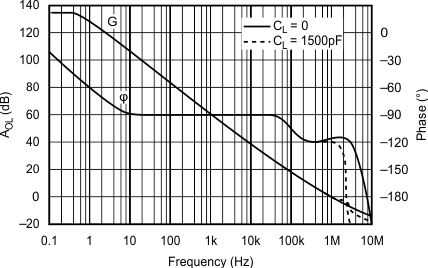
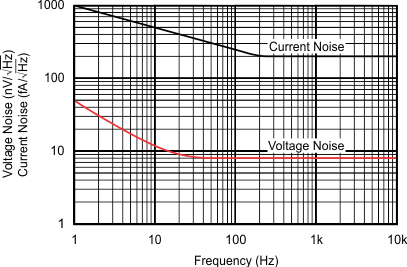
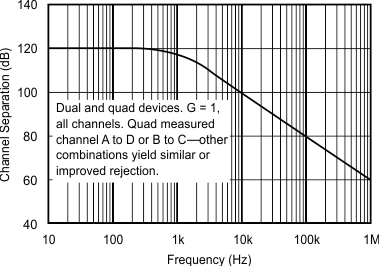
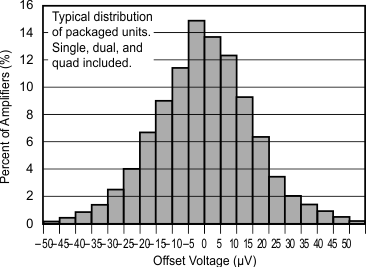
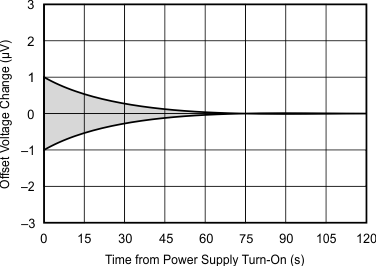
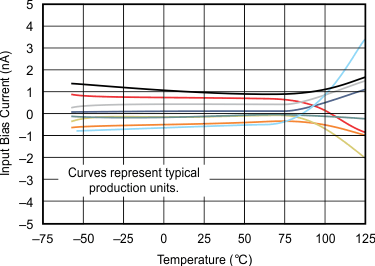
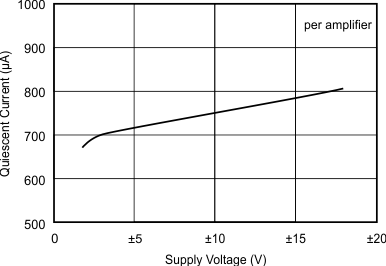
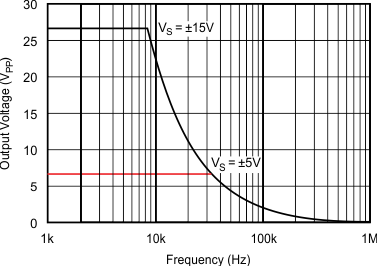
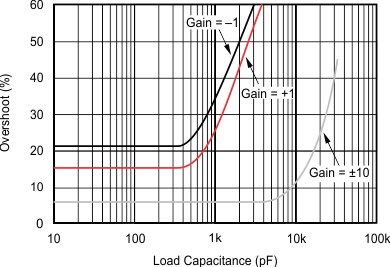
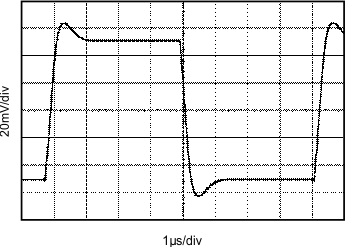
| G = 1 | CL = 0 pF | VS = 15 V |
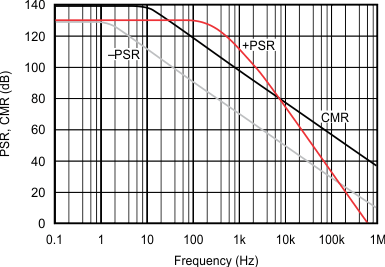
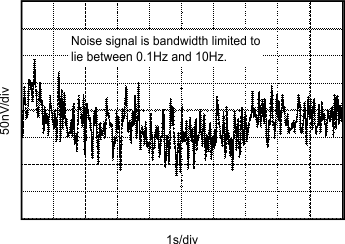
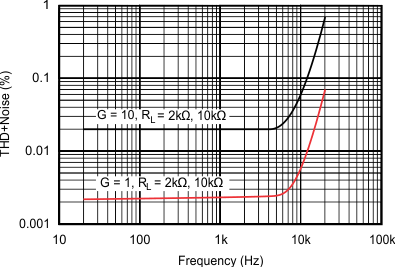
| VOUT = 3.5 Vrms |
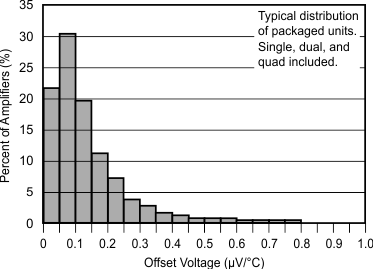
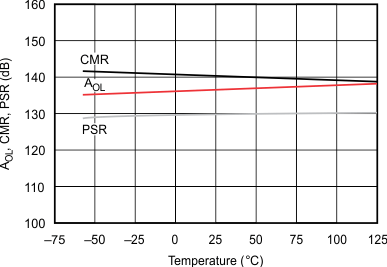
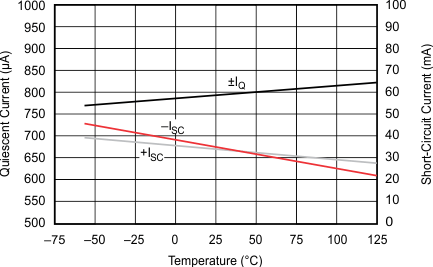
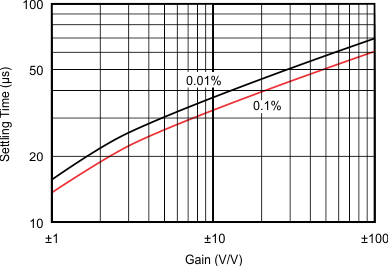
| 10-V step | CL = 1500 pF |
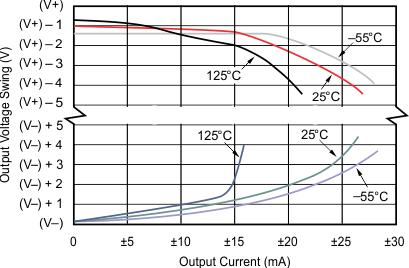
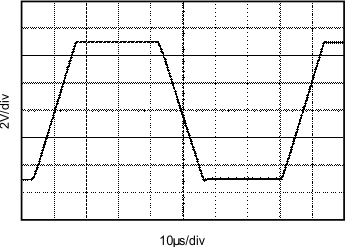
| G = 1 | CL = 1500 pF | VS = 15 V |
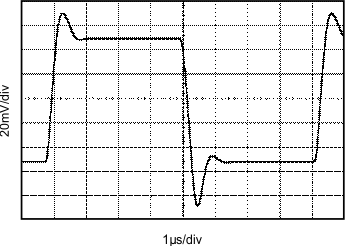
| G = 1 | CL = 1500 pF | VS = 15 V |